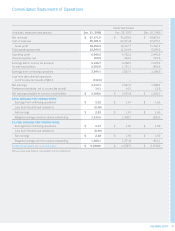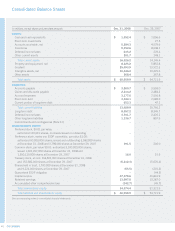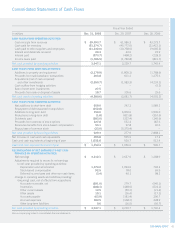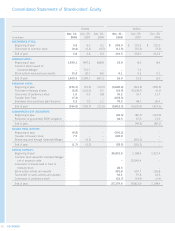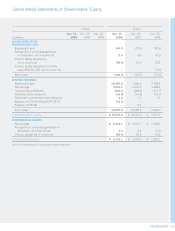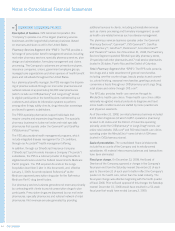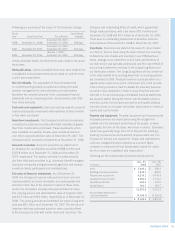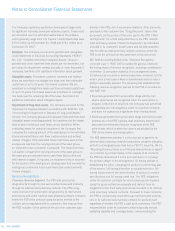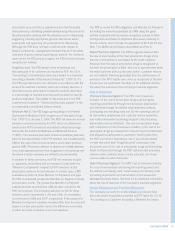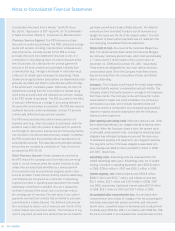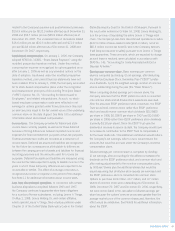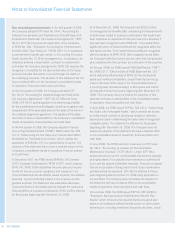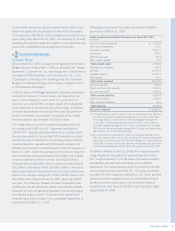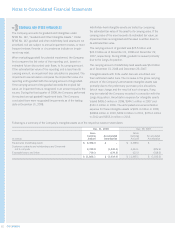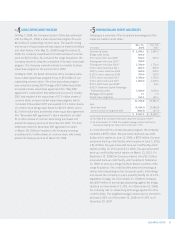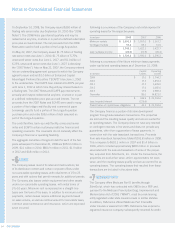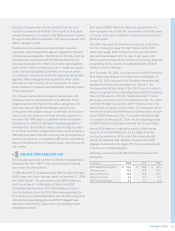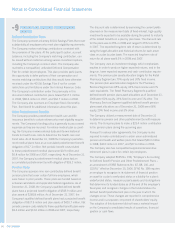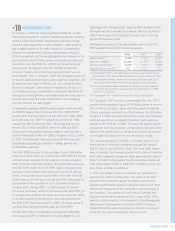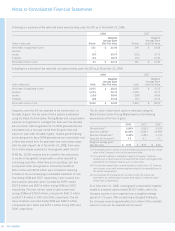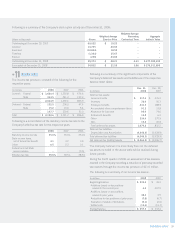CVS 2008 Annual Report Download - page 53
Download and view the complete annual report
Please find page 53 of the 2008 CVS annual report below. You can navigate through the pages in the report by either clicking on the pages listed below, or by using the keyword search tool below to find specific information within the annual report.
2008 ANNUAL REPORT 49
States Bankruptcy Court for the District of Delaware. Pursuant to
the court order entered on October 16, 2008, Linens Holding Co.
is in the process of liquidating the entire Linens ‘n Things retail
chain. The Company’s loss from discontinued operations includes
$132.0 million of lease-related costs ($214.4 million, net of an
$82.4 million income tax benefi t), which the Company believes
it will likely be required to satisfy pursuant to its Linens ‘n Things
lease guarantees. These amounts, which are expected to change
as each lease is resolved, were calculated in accordance with
SFAS No. 146, “Accounting for Costs Associated with Exit or
Disposal Activities.”
Earnings per common share. Basic earnings per common
share is computed by dividing: (i) net earnings, after deducting
the after-tax Employee Stock Ownership Plan (“ESOP”) prefer-
ence dividends, by (ii) the weighted average number of common
shares outstanding during the year (the “Basic Shares”).
When computing diluted earnings per common share, the
Company assumes that the ESOP preference stock is converted
into common stock and all dilutive stock awards are exercised.
After the assumed ESOP preference stock conversion, the ESOP
Trust would hold common stock rather than ESOP preference
stock and would receive common stock dividends ($0.25800
per share in 2008, $0.22875 per share in 2007 and $0.15500
per share in 2006) rather than ESOP preference stock dividends
(currently $3.90 per share). Since the ESOP Trust uses the
dividends it receives to service its debt, the Company would have
to increase its contribution to the ESOP Trust to compensate it
for the lower dividends. This additional contribution would reduce
the Company’s net earnings, which in turn, would reduce the
amounts that would be accrued under the Company’s incentive
compensation plans.
Diluted earnings per common share is computed by dividing:
(i) net earnings, after accounting for the difference between the
dividends on the ESOP preference stock and common stock and
after making adjustments for the incentive compensation plans,
by (ii) Basic Shares plus the additional shares that would be
issued assuming that all dilutive stock awards are exercised and
the ESOP preference stock is converted into common stock.
Options to purchase 20.9 million, 10.7 million, and 4.7 million
shares of common stock were outstanding as of December 31,
2008, December 29, 2007 and December 30, 2006, respectively,
but were not included in the calculation of diluted earnings per
share because the options’ exercise prices were greater than the
average market price of the common shares and, therefore, the
effect would be antidilutive. See Note 8 for additional information
about the ESOP.
related to the Company’s pension and post retirement plans was
$216.9 million pre-tax ($132.3 million after-tax) as of December 31,
2008 and $58.7 million pre-tax ($35.9 million after-tax) as of
December 29, 2007. The unrealized loss on derivatives totaled
$16.6 million pre-tax ($10.5 million after-tax) and $21.9 million
pre-tax ($13.8 million after-tax) as of December 31, 2008 and
December 29, 2007, respectively.
Stock-based compensation. On January 1, 2006, the Company
adopted SFAS No. 123(R), “Share-Based Payment,” using the
modifi ed prospective transition method. Under this method,
compensation expense is recognized for options granted on or
after January 1, 2006 as well as any unvested options on the
date of adoption. As allowed under the modifi ed prospective
transition method, prior period fi nancial statements have not
been restated. Prior to January 1, 2006, the Company accounted
for its stock-based compensation plans under the recognition
and measurement principles of Accounting Principles Board
(“APB”) Opinion No. 25, “Accounting for Stock Issued to
Employees,” and related interpretations. As such, no stock-
based employee compensation costs were refl ected in net
earnings for options granted under those plans since they had
an exercise price equal to the fair market value of the underlying
common stock on the date of grant. See Note 10 for additional
information about stock-based compensation.
Income taxes. The Company provides for federal and state
income taxes currently payable, as well as for those deferred
because of timing differences between reported income and
expenses for fi nancial statement purposes versus tax purposes.
Federal and state tax credits are recorded as a reduction of
income taxes. Deferred tax assets and liabilities are recognized
for the future tax consequences attributable to differences
between the carrying amount of assets and liabilities for fi nancial
reporting purposes and the amounts used for income tax
purposes. Deferred tax assets and liabilities are measured using
the enacted tax rates expected to apply to taxable income in the
years in which those temporary differences are expected to be
recoverable or settled. The effect of a change in tax rates is
recognized as income or expense in the period of the change.
See Note 11 for additional information about income taxes.
Loss from discontinued operations. In connection with certain
business dispositions completed between 1991 and 1997,
the Company continues to guarantee store lease obligations
for a number of former subsidiaries, including Linens ‘n Things.
On May 2, 2008, Linens Holding Co. and certain affi liates,
which operate Linens ‘n Things, fi led voluntary petitions under
Chapter 11 of the United States Bankruptcy Code in the United


